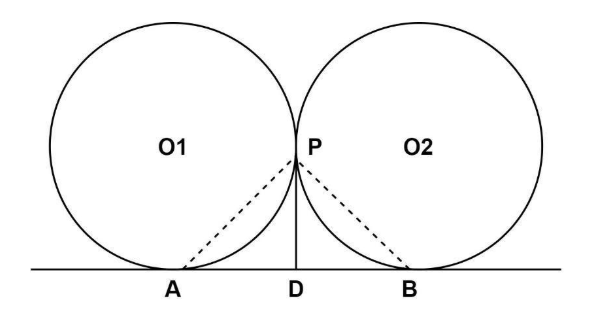
Two circles touch each other externally at P. AB is a common tangent to the circles touching them at A and B. The value of $\angle APB$ is
A. ${30^0}$
B. ${45^0}$
C. ${60^0}$
D. ${90^0}$
Answer
603.3k+ views
Hint: Draw the diagrams as given in the problem and use geometrical theorems involving tangents to the circle and triangles to solve the problem.
Complete step-by-step answer:
Given the problem, two circles touch each other externally at P.
Let O1 and O2 be the two circles touching each other externally at point P.
Also, AB is a common tangent to the circles touching them at A and B.
We need to find the value of $\angle APB$.

It is a well-known theorem that lengths of tangents drawn from an external point to a circle are equal.
Hence tangent AD = DP for circle O1 and tangent DB = DP for circle O2.
Also, angles opposite to equal sides of a triangle are equal.
Therefore, in $\Delta ADP$,
$\angle DAP = \angle DPA{\text{ (1)}}$
Similarly, in $\Delta DPB$
$\angle DPB = \angle DBP{\text{ (2)}}$
We know that the sum of all the angles within a triangle is equal to ${180^0}$.
Using this rule in $\Delta APB$ , we get,
$\angle PAB + \angle PBA + \angle BPA = {180^0}\,{\text{ (3)}}$
Also, from figure, it is clear that
$
\angle BPA = \angle DPA + \angle DPB \\
\angle PAB = \angle DAP \\
\angle PBA = \angle DBP \\
$
Using the above obtained results in equation $(3)$ , we get,
$\angle DAP + \angle DBP + \angle DPA + \angle DPB = {180^0}$
Now using the result obtained in equations $(1)$and $(2)$ in above
\[
\Rightarrow \angle DPA + \angle DPB + \angle DPA + \angle DPB = {180^0} \\
\Rightarrow 2\left( {\angle DPA + \angle DPB} \right) = {180^0} \\
\Rightarrow \left( {\angle DPA + \angle DPB} \right) = {90^0}{\text{ (4)}} \\
\]
As obtained earlier from figure, $\angle BPA = \angle DPA + \angle DPB$
Using this in equation $(4)$, we get
$\angle BPA = \angle APB = {90^0}$
Hence the value of $\angle APB$ is ${90^0}$.
Therefore, option (D), ${90^0}$ is the correct answer.
Note: The geometric theorems related to circles and triangles should be kept in mind in problems like above. Special attention should be paid while making the diagram from the problem as it should accurately depict the conditions given in the problem.
Complete step-by-step answer:
Given the problem, two circles touch each other externally at P.
Let O1 and O2 be the two circles touching each other externally at point P.
Also, AB is a common tangent to the circles touching them at A and B.
We need to find the value of $\angle APB$.

It is a well-known theorem that lengths of tangents drawn from an external point to a circle are equal.
Hence tangent AD = DP for circle O1 and tangent DB = DP for circle O2.
Also, angles opposite to equal sides of a triangle are equal.
Therefore, in $\Delta ADP$,
$\angle DAP = \angle DPA{\text{ (1)}}$
Similarly, in $\Delta DPB$
$\angle DPB = \angle DBP{\text{ (2)}}$
We know that the sum of all the angles within a triangle is equal to ${180^0}$.
Using this rule in $\Delta APB$ , we get,
$\angle PAB + \angle PBA + \angle BPA = {180^0}\,{\text{ (3)}}$
Also, from figure, it is clear that
$
\angle BPA = \angle DPA + \angle DPB \\
\angle PAB = \angle DAP \\
\angle PBA = \angle DBP \\
$
Using the above obtained results in equation $(3)$ , we get,
$\angle DAP + \angle DBP + \angle DPA + \angle DPB = {180^0}$
Now using the result obtained in equations $(1)$and $(2)$ in above
\[
\Rightarrow \angle DPA + \angle DPB + \angle DPA + \angle DPB = {180^0} \\
\Rightarrow 2\left( {\angle DPA + \angle DPB} \right) = {180^0} \\
\Rightarrow \left( {\angle DPA + \angle DPB} \right) = {90^0}{\text{ (4)}} \\
\]
As obtained earlier from figure, $\angle BPA = \angle DPA + \angle DPB$
Using this in equation $(4)$, we get
$\angle BPA = \angle APB = {90^0}$
Hence the value of $\angle APB$ is ${90^0}$.
Therefore, option (D), ${90^0}$ is the correct answer.
Note: The geometric theorems related to circles and triangles should be kept in mind in problems like above. Special attention should be paid while making the diagram from the problem as it should accurately depict the conditions given in the problem.
Recently Updated Pages
Master Class 12 Economics: Engaging Questions & Answers for Success

Master Class 12 Maths: Engaging Questions & Answers for Success

Master Class 12 Biology: Engaging Questions & Answers for Success

Master Class 12 Physics: Engaging Questions & Answers for Success

Master Class 8 Maths: Engaging Questions & Answers for Success

Class 8 Question and Answer - Your Ultimate Solutions Guide

Trending doubts
Why is there a time difference of about 5 hours between class 10 social science CBSE

Write a letter to the principal requesting him to grant class 10 english CBSE

What is the median of the first 10 natural numbers class 10 maths CBSE

The Equation xxx + 2 is Satisfied when x is Equal to Class 10 Maths

Which of the following does not have a fundamental class 10 physics CBSE

State and prove converse of BPT Basic Proportionality class 10 maths CBSE




